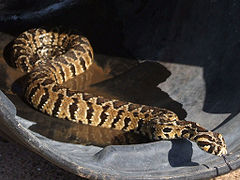
Vipera palaestinae
Encyclopedia
- Common names: Palestine viper, Palestinian viper.
Vipera palaestinae is a venomous
Venomous snake
"Poisonous snake" redirects here. For true poisonous snakes, see Rhabdophis.Venomous snakes are snakes which have venom glands and specialized teeth for the injection of venom...
viper
Viperinae
The Viperinae, or viperines, are a subfamily of venomous vipers found in Europe, Asia and Africa. They are distinguished by their lack of the heat-sensing pit organs that characterize their sister group, the Crotalinae. Currently, 12 genera and 66 species are recognized...
species
Species
In biology, a species is one of the basic units of biological classification and a taxonomic rank. A species is often defined as a group of organisms capable of interbreeding and producing fertile offspring. While in many cases this definition is adequate, more precise or differing measures are...
found in the geographical region of Palestine
Palestine
Palestine is a conventional name, among others, used to describe the geographic region between the Mediterranean Sea and the Jordan River, and various adjoining lands....
, more specifically, an area spanning western Syria
Syria
Syria , officially the Syrian Arab Republic , is a country in Western Asia, bordering Lebanon and the Mediterranean Sea to the West, Turkey to the north, Iraq to the east, Jordan to the south, and Israel to the southwest....
, northwestern Jordan
Jordan
Jordan , officially the Hashemite Kingdom of Jordan , Al-Mamlaka al-Urduniyya al-Hashemiyya) is a kingdom on the East Bank of the River Jordan. The country borders Saudi Arabia to the east and south-east, Iraq to the north-east, Syria to the north and the West Bank and Israel to the west, sharing...
, northern and central Israel
Israel
The State of Israel is a parliamentary republic located in the Middle East, along the eastern shore of the Mediterranean Sea...
, the West Bank
West Bank
The West Bank ) of the Jordan River is the landlocked geographical eastern part of the Palestinian territories located in Western Asia. To the west, north, and south, the West Bank shares borders with the state of Israel. To the east, across the Jordan River, lies the Hashemite Kingdom of Jordan...
and Lebanon
Lebanon
Lebanon , officially the Republic of LebanonRepublic of Lebanon is the most common term used by Lebanese government agencies. The term Lebanese Republic, a literal translation of the official Arabic and French names that is not used in today's world. Arabic is the most common language spoken among...
. It is considered a leading cause of snakebite
Snakebite
A snakebite is an injury caused by a bite from a snake, often resulting in puncture wounds inflicted by the animal's fangs and sometimes resulting in envenomation. Although the majority of snake species are non-venomous and typically kill their prey with constriction rather than venom, venomous...
within its range. No subspecies are currently recognized.
Description

Geographic range
Northern and central Israel, West Bank, western Syria, northwestern Jordan, and Lebanon. Mallow et al. (2003) describe the range as relatively restricted, with the distribution being concentrated in the Mediterranean coastal plains to the inland hills of Lebanon and Israel, along with the adjoining regions of Syria and Jordan. The type locality given is "HaifaHaifa
Haifa is the largest city in northern Israel, and the third-largest city in the country, with a population of over 268,000. Another 300,000 people live in towns directly adjacent to the city including the cities of the Krayot, as well as, Tirat Carmel, Daliyat al-Karmel and Nesher...
, Palästina."
Conservation status
This species is classified as Least Concern (LC) according to the IUCN Red List of Threatened Species (v3.1, 2001). It was given this status due to its relatively wide distribution, the fact that it is found in a wide range of habitats, its presumed large population, and because it is unlikely to be declining fast enough to qualify for listing in a more threatened category. The population trend is unknown. Year assessed: 2005.Taxonomy
The classification of this species has resulted in much taxonomic controversy. Before Werner (1938), these snakes were incorporated into V. xanthinaVipera xanthina
Vipera xanthina is a venomous viper species found in northeastern Greece and Turkey, as well as certain islands in the Aegean Sea. No subspecies are currently recognized.-Description:...
, and subsequently synonymized with V. lebetina
Macrovipera lebetina
Macrovipera lebetina is a venomous viper species found in North Africa, much of the Middle East, and as far east as Kashmir. Five subspecies are currently recognized, including the nominate race described here.-Description:...
by Boulenger (1896). Mertens (1952) moved it back to V xanthina as a subspecies, and more recently a number of authorities, including Obst (1983) and Mallow et al. (2003) have included it as part of the genus Daboia
Daboia
Daboia is a monotypic genus of venomous Old World viper. The single species, D. russelii, is found in Asia throughout the Indian subcontinent, much of Southeast Asia, southern China and Taiwan...
. The result is that many studies related to this medically significant species have been published under different scientific names.

